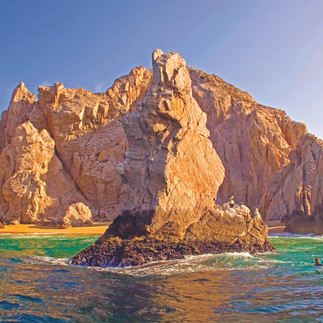Los Cabos
- Karen Bartlett
- Feb 25, 2023
- 4 min read
Kissing a Gray Whale and Other Out-of-Body Experiences

Golden Sonoran Desert beach at Los Cabos | Photo by Karen T. Bartlett
Sunrise. A soft breeze is blowing off the Sea of Cortez, across my balcony, and into my super-luxe beachfront casita. Not my upper balcony, atop the bougainvillea-draped stone staircase, where yesterday I lunched on lobster beside my private rooftop pool, but my bedroom-level balcony, with 180-degree views of palm trees and silky golden sand studded with jagged granite rocks. Last night some astronomers came with telescopes to show hotel guests the pinky-gold rings of Saturn, so breathtakingly visible in Mexico’s dark sky region of Los Cabos-Baja, California. Tonight, I’m booked for two hours of bliss in a super-upscaled version of a centuries-old indigenous healing experience.
Right now, I’m focused on my upcoming zodiac tour to witness the annual migration of humpback whales, which happens between mid-December and mid-April. My late-March timing is perfect. But alas, it seems the whales are already packing their bags for the 5,000-mile return to the Bering Sea. The outfitter has canceled today’s trip to avoid disappointment. Maybe tomorrow.
L to R: A "suite" beach view at Las Ventanas al Paraiso (Rosewood Hotels), Lunch served in traditional earthenware | Photo by Karen T. Bartlett, Playa del Amor near El Arco | Photo by Karen T. Bartlett
Instead, I’m joining an outback excursion into the Sonoran Desert with Cabo Adventures.
Our 4x4 vehicle bounces through ravines, up hillsides, and between giant cardon cacti to a small ranch, where the family is preparing a homestyle local meal. First, there’s mezcal, derived from the fruit of their own blue agave plants which, through several distillations, eventually becomes tequila. I’m a bit fuzzy on the details, as the tiny earthen cup on the ribbon around my neck flows endlessly with the fermented nectar. Salt and lime temper the lava flow down the throat, but I’m still lucid enough to decline the appetizer: a platter of crispy baked crickets. The homemade mole, tortillas, rice and beans, salsas, guacamole, and baked prickly pear cactus are delicious.

Humpback whale shows off her fluke | Photo by Karen T. Bartlett
Whale Quest
The next day around lunchtime, hallelujah, a humpback whale is spotted near the hotel. Within two hours I’m aboard an inflatable 15-passenger zodiac puttering to the end of the earth, where the picturesque El Arco rock marks the convergence of the Pacific Ocean with the Sea of Cortez. We glide past secluded Playa del Amor where movie stars play, and a colony of sea lions dozing in the afternoon sun.

“Please understand that we may not spot any whales” repeats our guide. “It’s nature, and each season is different.”
“Just show me one humpback fluke,” I whisper to the whale gods. “Just one.” Suddenly, a huge black and white fluke rises in the near distance. Now we’re flying across the water and soon we’re close enough to see her barnacles. Then there’s another, and another, and two more. There are no breaches, but I’m perfectly happy. Still, the whale gods aren’t finished.
“Wait,” they seem to say, “watch this!” The biggest whale so far glides right alongside us, then slaps the water with a flourish, bathing herself (and us) in a silvery halo of sea spray before she heads into the sunset.
Epilogue: Local outfitters have gotten significantly more creative in recent years (even some desert camel rides), adding thoughtful eco-experiences. Instead of crickets on the menu, Cabo Adventures now partners with an educational eco-farm. Best of all, even the most recreational whale-watching has evolved from human entertainment to respectful interaction with the beings who share mother ocean with us.

Sea lion colony basking in the sun | Photo by Karen T. Bartlett
Gray Whales:
Puppies of the Sea of Cortez
Almost every gray whale in the world takes its first breath in Baja California. Ponder that for a moment. According to researchers, gray whales are among the world’s wild species that seek out and enjoy human touch. Right now, while the humpback whales are cavorting on the Pacific side of Los Cabos, performing for their own well-being and entertainment but not particularly interested in a personal encounter, a few quiet lagoons in the warmer Sea of Cortez are filled with mating, calving, and nursing gray whales who love meet-and-greets as much as we do. The mothers and calves interact with humans strictly on their own terms and eye-to-eye encounters (and hugging and kissing) are common. According to the marine scientists at Baja Expeditions, who have studied these grays for decades, the mamas even push their babies up to the boat to be stroked, get scratched behind the ears, and jump up for full-body hugs like giant puppies.
All the calving lagoons are under strict federal protection and some, like Cabo Whale Trek, are certified as a Responsible Whale Watching Operator by the World Cetacean Alliance. Instead of big-party zodiacs, they offer comfy shaded panga boats that carry fewer guests.
World’s Richest Sport Fishing Tournament
Sports fishermen, sign up for Bisbee’s famous Black & Blue Marlin Tournament in October, which has paid out over $11 million in a single year. The record catch (so far) is a 993-pound blue marlin. Even if you don’t fish, do watch the movie Blue Miracle, based on the true story of how local children from a financially struggling orphanage took home the big purse. They’re no longer struggling.
If You’re Going
The wilder the adventure, the more you might crave a luxurious sleep. Some suggestions:
WaldorfAstoriaLosCabosPedregal.com
MarquisLosCabos.com
OneAndOnlyResorts.com/palmilla
rosewoodhotels.com/en/las-ventanas-los-cabos
Learn more
VisitLosCabos.travel
cabo-adventures.com
CaboWhaleTrek.com
BajaEx.com
Bisbees.com










Comments